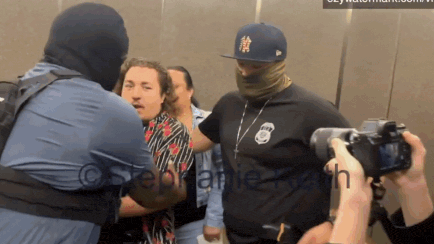A Troubling Incident Raises Questions About Press Access and Government Accountability
The relationship between federal law enforcement and the press reached a new flashpoint this week when Immigration and Customs Enforcement (ICE) agents physically confronted journalists covering immigration enforcement activities at a Manhattan immigration court. The incident, which left at least one reporter injured, has ignited a fierce debate about press freedom, government transparency, and the boundaries of federal authority in an era of heightened immigration enforcement.
Video footage of the confrontation shows federal agents shoving journalists who were attempting to follow them into an elevator, marking yet another concerning chapter in the ongoing tension between media coverage and immigration enforcement operations under the current administration’s policies.
The Manhattan Courthouse Confrontation: What Happened
The incident unfolded at the Manhattan Immigration Court, a facility that has become a focal point for immigration enforcement activities in one of America’s most densely populated urban areas. According to eyewitness accounts and video evidence, federal agents were conducting what appears to have been a routine immigration enforcement action when journalists arrived to document the proceedings.
As reporters attempted to follow the federal agents into an elevator to continue their coverage, the situation quickly escalated. The confrontation resulted in journalists being physically pushed and at least one reporter sustaining injuries during the altercation. The incident was captured on video, providing clear documentation of the physical contact between federal agents and members of the press.
Immediate Aftermath and Responses
The Department of Homeland Security, which oversees ICE operations, quickly moved to defend the actions of their agents. In a statement released following the incident, DHS officials argued that their personnel were acting within their authority and following established protocols for maintaining security during enforcement operations.
However, this defense has done little to quell the growing criticism from press freedom advocates, legal experts, and civil liberties organizations who view the incident as part of a troubling pattern of hostility toward journalistic coverage of immigration enforcement activities.
The Broader Context: Immigration Enforcement and Media Relations
This confrontation cannot be viewed in isolation. It occurs against the backdrop of increasingly aggressive immigration enforcement policies and a corresponding increase in media attention to these activities. Immigration courts across the United States have become critical venues where the human impact of federal immigration policy plays out on a daily basis.
The Role of Immigration Courts
Immigration courts serve as the judicial backbone of the U.S. immigration system, processing hundreds of thousands of cases annually. These venues have traditionally been accessible to the public and press, operating under the principle that transparency in judicial proceedings serves the public interest. However, the increased security concerns and enforcement priorities of recent years have created new tensions around access and coverage.
Manhattan’s immigration court, in particular, handles a significant caseload that reflects the diverse immigrant population of New York City and surrounding areas. The facility regularly sees cases involving asylum seekers, individuals facing deportation proceedings, and families navigating complex immigration status issues.
Press Freedom Implications and Legal Precedents
The physical confrontation between federal agents and journalists raises serious questions about First Amendment protections and the public’s right to know about government enforcement activities. Legal experts point to a long history of court decisions that have generally supported the media’s right to cover government operations, particularly in public spaces and judicial venues.
Constitutional Considerations
The First Amendment’s protection of press freedom has been interpreted by courts to include not just the right to publish information, but also the right to gather news. This newsgathering function is considered essential to the media’s role as a watchdog over government activities and a conduit for public information.
When federal agents physically prevent journalists from documenting government enforcement actions, they potentially infringe upon these constitutional protections. The fact that the incident occurred at a courthouse – traditionally a venue open to public scrutiny – makes the confrontation even more concerning from a legal perspective.
Industry Response and Press Freedom Advocacy
Major press freedom organizations have quickly mobilized in response to the Manhattan courthouse incident. The Committee to Protect Journalists, the Society of Professional Journalists, and other advocacy groups have issued statements condemning the agents’ actions and calling for accountability and policy changes to prevent similar incidents in the future.
Patterns of Concern
Press freedom advocates argue that this incident is part of a broader pattern of hostility toward media coverage of immigration enforcement. They point to other recent examples where journalists covering immigration stories have faced obstacles, intimidation, or restrictions on their ability to report on these important public interest matters.
These organizations are calling for clear policies that protect journalists’ ability to cover immigration enforcement while acknowledging legitimate security concerns that federal agents may have during their operations.
Balancing Security and Transparency
The challenge facing federal agencies lies in balancing legitimate security concerns with the public’s right to transparency in government operations. Immigration enforcement often involves sensitive situations and potentially dangerous individuals, creating genuine security considerations that agents must navigate.
However, critics argue that physical confrontation with journalists should never be the first response to these concerns. Alternative approaches, such as establishing clear protocols for media access, creating designated areas for press coverage, or implementing advance coordination procedures, could potentially address security needs while preserving press freedom.
Looking Forward: Policy Implications and Reforms
This incident is likely to prompt renewed discussions about federal policies governing media relations during enforcement operations. Congressional oversight committees may examine whether current protocols adequately protect press freedom while ensuring operational security.
Potential Solutions
Legal experts and press freedom advocates are proposing several potential reforms, including:
- Enhanced training for federal agents on First Amendment rights and appropriate interaction with the media
- Clear written policies governing press access during enforcement operations
- Accountability measures for agents who unnecessarily restrict or physically confront journalists
- Coordination protocols that allow for both operational security and press access
The Stakes for Democracy
Beyond the immediate circumstances of this incident lies a fundamental question about the role of press coverage in maintaining democratic accountability. Immigration enforcement, like all government activities, benefits from public scrutiny and oversight. When journalists are prevented from covering these activities, the public loses a crucial window into how their government operates.
The Manhattan courthouse confrontation serves as a reminder that press freedom requires constant vigilance and protection, particularly in areas where government enforcement activities intersect with sensitive political issues like immigration.
Key Takeaways
- Federal agents physically confronted journalists at a Manhattan immigration court, injuring at least one reporter
- The incident raises serious First Amendment concerns about press freedom and public access to government operations
- Immigration courts have traditionally been open to public and press scrutiny as part of judicial transparency
- Press freedom organizations are demanding accountability and policy changes to prevent future confrontations
- The incident reflects broader tensions between immigration enforcement priorities and media coverage
- Clear protocols and training could help balance security needs with constitutional press protections
- Democratic oversight depends on media access to government enforcement activities

Born and raised amidst the hustle and bustle of the Big Apple, I’ve witnessed the city’s many exciting phases. When I’m not exploring the city or penning down my thoughts, you can find me sipping on a cup of coffee at my favorite local café, playing chess or planning my next trip. For the last twelve years, I’ve been living in South Williamsburg with my partner Berenike.

